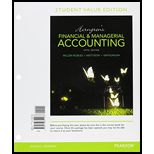
Concept explainers
Journalizing transactions, posting
Trevor Moore opened a law office on April1, 2017. During the first month of operations, the business completed the following transactions:
Apr. 1 Moore contributed $76,000 cash to the business, Trevor Moore. Attorney. The business issued common stock to Moore.
3 Purchased office supplies, $400, and furniture, $2,200, on account.
4 Performed legal services for a client and received $900 cash.
7 Purchased a building with a market value of $120,000, and land with a market value of $29,000. The business paid $45,000 cash and signed a note payable to the bank for the remaining amount.
| 11 | Prepared legal documents for a client on account, $800. |
| 15 | Paid assistant’s semimonthly salary, $1,230. |
| 16 | Paid for the office supplies purchased on April 3 on account. |
| 18 | Received $2,800 cash for helping a client sell real estate. |
| 19 | Defended a client in court and billed the client for $1,500. |
| 25 | Received a bill for utilities, $650. The bill will be paid next month. |
| 28 | Received cash on account, $1,700. |
| 29 | Paid $4,800 cash for a 12-month insurance policy starting on May 1. |
| 29 | Paid assistant’s semimonthly salary, $1,230. |
| 30 | Paid monthly rent expense, $1,100. |
| 30 | Paid cash dividends of $2,000. |
Requirements
1. Record each transaction in the journal, using the following account titles: Cash ;
2. Open the following four-column accounts including account numbers: Cash, 101; Accounts Receivable, 111; Office Supplies, 121; Prepaid Insurance, 131; Furniture, 141; Building, 151; Land, 161; Accounts Payable, 201; Utilities Payable, 211;
Notes Payable, 221; Common Stock, 301; Dividends, 311; Service Revenue, 411; Salaries Expense, 511; Rent Expense, 521; and Utilities Expense, 531.
3. Post the journal entries to four-column accounts in the ledger, using dares, account numbers, journal references, and posting references. Assume the journal entries were recorded on page 1 of the journal.
4. Prepare the trial balance of Trevor Moore, Attorney, at April 30, 2017.
Want to see the full answer?
Check out a sample textbook solution
Chapter 2 Solutions
Horngren's Financial & Managerial Accounting, Student Value Edition Plus MyLab Accounting with Pearson eText -- Access Card Package (5th Edition)
- Colfax Company incurred production labor costs of $5,400 in February (payable In March) for work requiring 1,100 standard hours at a standard rate of $15 per hour; 1,200 actual direct labor hours were worked. Based on this information, which one of the following would be included in the journal entry to record the labor costs? a. $16,500 credit to Work-in-process Inventory. b. $1,500 credit to labor Efficiency Variance. c. $16,200 credit to Wages Payable. d. $1,500 credit to Labor Rate Variance.arrow_forwardConsider the following event: Owner made contribution to the firm. Which of the following combination of changes in the accounting equation describes the given event? a. Liabilities decrease; Owners' equity increase b. Assets decrease; Liabilities decrease c. Assets decrease; Owners' equity decrease d. Assets increase; Assets decrease e. Assets increase; Liabilities increase f. Assets increase; Owners' equity increasearrow_forwardSUBJECT = GENERAL ACCOUNTarrow_forward
- this is general account questionarrow_forwardThompson Company has a standard of 3.1 pounds of materials per unit, at $15.10 per pound. In producing 980 units, Thompson used 2,830 pounds of materials at a total cost of $44,500. What is Thompson's total materials variance? a. $1,767 Favorable b. $1,374 Favorable c. $1,374 Unfavorable d. $1,767 Unfavorablearrow_forwardFinancial Accountarrow_forward
- A parcel of land that was originally purchased for $85,000 is offered for sale at $150,000, is assessed for tax purposes at $95,000, is recognized by its purchasers as easily being worth $140,000, and is sold for $137,000. What is the effect of the sale on the accounting equation for the seller? A) Assets increase by $52,000; owner's equity increases by $52,000. B) Assets increase by $85,000; owner's equity increases by $85,000. C) Assets increase by $137,000; owner's equity increases by $137,000. D) Assets increase by $140,000; owner's equity increases by $140,000. E) None of the above.arrow_forwardNeed general account solutionsvarrow_forwardGeneral accountarrow_forward
- Overhead application to costs is a critical issue for the costing of your products. We are studying several ways to handle this situation. Describe overhead and the overhead application process. What would cause an overhead to be overapplied, or underapplied. Discuss the results to your decision making and the financial statements for each of those two situations. Describe how the over or under application of overhead should be corrected in the accounting records.arrow_forwardDon't use ai to answer I will report you answerarrow_forwardi need this question answer General accounting questionarrow_forward
- Principles of Accounting Volume 1AccountingISBN:9781947172685Author:OpenStaxPublisher:OpenStax College
 College Accounting (Book Only): A Career ApproachAccountingISBN:9781305084087Author:Cathy J. ScottPublisher:Cengage Learning
College Accounting (Book Only): A Career ApproachAccountingISBN:9781305084087Author:Cathy J. ScottPublisher:Cengage Learning Financial AccountingAccountingISBN:9781305088436Author:Carl Warren, Jim Reeve, Jonathan DuchacPublisher:Cengage Learning
Financial AccountingAccountingISBN:9781305088436Author:Carl Warren, Jim Reeve, Jonathan DuchacPublisher:Cengage Learning  College Accounting (Book Only): A Career ApproachAccountingISBN:9781337280570Author:Scott, Cathy J.Publisher:South-Western College Pub
College Accounting (Book Only): A Career ApproachAccountingISBN:9781337280570Author:Scott, Cathy J.Publisher:South-Western College Pub Financial AccountingAccountingISBN:9781337272124Author:Carl Warren, James M. Reeve, Jonathan DuchacPublisher:Cengage Learning
Financial AccountingAccountingISBN:9781337272124Author:Carl Warren, James M. Reeve, Jonathan DuchacPublisher:Cengage Learning




